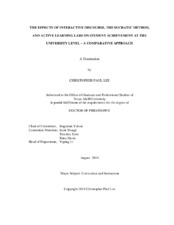| dc.description.abstract | The primary purpose of this study was to examine and provide an observational analysis for a non-traditional, undergraduate biology classroom at a research I university in the southern United States. This study employed a mixed methods design. The researcher collected qualitative data associated with the design of the non-traditional classroom, input from the professor (Dr. X) whose class was being analyzed, input from her teaching assistants as well as student perceptions of these biology courses. The main research question guiding this study was: What are the unique characteristics of Dr. X’s biology classes and what impact do they have on students’ learning outcomes and experiences?
The results of this study were as follows:
1) The scope, sequence, and desired student outcomes of Dr. X’s biology courses deviate radically from the traditional biology courses at the same university.
2) Dr. X’s students felt that Dr. X’s teaching style was discussion based and that it was their job to make sense of the in-class material and outside readings.
3) The majority of Dr. X’s students reported that Dr. X instructed them to develop life-long learning skills and be passionately curious about the knowledge of biology.
4) T-Test and ANCOVA statistical analysis showed three statistically significant student achievement outcomes. Dr. X’s students’ grades were statistically significantly higher at the Biology 111 and Biology 112 levels when compared to students taking Biology 111 and 112 in the traditional biology class formats. Students taking Biology 111 and 112 in the traditional biology class formats attained significantly higher grades within Biology 213 – the next biology course taken by biology majors after Biology 111 and Biology 112.
The future of STEM education resides within the science education community’s ability to assess new strategies, validate preexisting strategies, and to be accountable for the teaching methodologies used by science educators. Dr. X represents a new strategy of teaching biology at the undergraduate level. Her strategy is a break from traditional science teaching that is often times teacher-centered and lacks any semblance of creativity, collaborative elaboration, engagement or connectedness.
Study participants were Dr. X, her teaching assistants, Dr. X’s students, as well as students from sections other than Dr. X has taught in the program. Students’ achievement data were obtained from a Grade Information Work Request via the university’s Enterprise Information System Office (EIS). Classroom observations and interviews with the participants were analyzed using qualitative research methods. The quantitative data were analyzed using statistical tests (e.g., t-test, ANCOVA).
The four themes that emerged from the analysis of the qualitative data collected were: (a) connections exist between different science subjects and Dr. X’s biology course material, (b) Dr. X’s course has a puzzle construction component, (c) Dr. X’s instruction is learner-centered, and (d) students in Dr. X’s courses are encouraged to think critically. The results of this study were as follows:
1) The scope, sequence, and desired student outcomes of Dr. X’s biology courses deviate radically from the traditional biology courses at the same university.
2) Dr. X’s students felt that Dr. X’s teaching style was discussion based and that it was their job to make sense of the in-class material and outside readings.
3) The majority of Dr. X’s students reported that Dr. X instructed them to develop life-long learning skills and be passionately curious about the knowledge of biology.
4) T-Test and ANCOVA statistical analysis showed three statistically significant student achievement outcomes. Dr. X’s students’ grades were statistically significantly higher at the Biology 111 and Biology 112 levels when compared to students taking Biology 111 and 112 in the traditional biology class formats. Students taking Biology 111 and 112 in the traditional biology class formats attained significantly higher grades within Biology 213 – the next biology course taken by biology majors after Biology 111 and Biology 112.
The future of STEM education resides within the science education community’s ability to assess new strategies, validate preexisting strategies, and to be accountable for the teaching methodologies used by science educators. Dr. X represents a new strategy of teaching biology at the undergraduate level. Her strategy is a break from traditional science teaching that is often times teacher-centered and lacks any semblance of creativity, collaborative elaboration, engagement or connectedness. | en |


